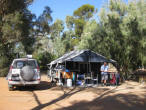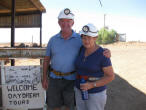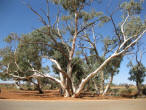|
western nsw trip
Mungo NP, Kinchega
NP, Silverton, Broken Hill and Mutawintji NP
by Joy Wilkinson

Panorama of the northern end of Mutawintji National
Park
It was
our plan to spend the 2 week Easter School Holidays on a touring holiday, but at
11 pm on the night before we were due to leave we doubted we would get away at
all. It all began with an unfamiliar metallic noise as we folded up the camper
after doing final checks on the poles. Further investigations revealed that one
of the bolts anchoring the fold-out tent framework had sheared right through and
the camper could not be folded up. Several desperate phone calls later, a call
from the manufacturer, and we had the camper folded, and an early morning
appointment in Gosford to fix the
problem. So began the BBB trip.
Day 1 Friday 10 April
2009 Good Friday
At 6.15 am David left Sydney for Gosford to have the bolt
problem fixed. This took over an hour to do (and an impressive amount of
goodwill on the manufacturer’s part), but David was back home quickly and we
finally set off from Pennant Hills about 9.30 am. We decided to travel via
Bathurst and stay overnight in West Wyalong. The trip was uneventful, with a bit
of rain through Cowra. Grenfell looks like an attractive town to explore, but on
this trip we didn’t have time. We stayed at West Wyalong Caravan Park in the
centre of town. Its sites are generous and several are well grassed.
One note for the traveller – be very wary of using the very
clean but very cold steel toilet seats in the park in Blayney, especially in the
winter.
Day 2 Saturday 11
April
After a little rain overnight we waited for the camper to dry
a little before setting off for Hay so we could stock up on fruit and vegetables
within the Fruit Fly Exclusion Zone. After lunching at Hay beside a historic
Aboriginal canoe tree, we set off for Balranald, watching some distant heavy
rain which seemed to be in a direct line between us and our destination, Lake
Mungo. Fortunately, someone else received the rain and the roads into Lake Mungo
were open. We arrived at about 4 pm and were lucky to gain the last spot in the
main campground.
The campground is well maintained and has BBQs and both
drinking and non potable water available. Fireplaces are available for cooking
and campfires and wood can be purchased. There are long drop toilets at the
campground, but the showers are a short drive away at the Visitor Centre.
Day 3 Sunday 12 April
During school holidays the Park conducts a number of free
guided tours daily. The first tour was a guided Foreshore Walk. Despite the fact
that Lake Mungo has been dry for thousands of years there is distinctly
different plant life on the foreshore area. The tour was very informative as the
guide pointed out different types of native plants, a massive bull ant nest, and
several types of bush food. The lake is about 11 km wide and there are excellent
views across the lake on this walk.
Later in the day we walked to the viewing platform which
gives excellent sunset colours on the eastern sand dunes, named the Walls of
China by early Chinese labourers in the days when Mungo was a sheep station. The
white dunes in the east contrast markedly with the red sandy soil of the western
side of the lake.
We had our solar panels set up through the day, topping up
the battery very well. But when the sun set, the second B of the trip raised its
ugly head. It became apparent that the battery wasn’t holding any charge so the
fridge wasn’t working. Thank goodness we had cryovacced the meat.
Day 4 Monday 13 April
Armed with handouts from the Visitor Centre we set off on the
self-guided driving tour around the lake. There are several points of interest
on the tour including: the old Mungo Woolshed where half a million sheep were
shorn; stockyards disappearing beneath the sand; a tumbledown hut undermined by
rabbit warrens and a trap for feral goats. However the most stunning features
are the eroded pinnacles and alluvial fans near the southern end of the Walls of
China. Further north are the massive sand hills near Vigars Well which used to
be a watering point for Cobb and Co coaches. The sand hills just invite
climbers, and are much steeper than they appear.
We also joined a Tag Along tour conducted by NPWS to a
different section of the Walls of China. The guides explained many items of
cultural significance in this area, and it was far more beneficial than visiting
the area without a guide. This area is very fragile and needs better protection
to preserve artefacts which are constantly being exposed by wind-blown sand.
As we left Mungo we were still amazed that early settlers
believed they could successfully run sheep in this arid and marginal area. The
damage caused by grazing and more recent feral animals will not easily be
rectified.
Day 5 Tuesday 14
April
As we left Lake Mungo heading for Kinchega National Park near
Menindee we made a minor revision to our plans due to the now dead battery. We
stopped at Pooncarie for morning tea and were amazed at the height of the flood
markers in the tree opposite the café and the extent of the root systems of the
red gums on the opposite bank. Instead of staying at Kinchega NP we decided to
stay at Copi Hollow as we needed a powered site. What an oasis! Soft green
grass! A great camping area (past all the on-site vans) with excellent
facilities owned by the Broken Hill Speed boat Club.
Day 6 Wednesday 15
April
It was David’s birthday, so I lashed out and generously
bought him a T shirt from the very helpful Information Centre in Menindee,
before heading out to Kinchega National Park.
We followed the River Drive past many lovely campsites where
we might have stayed (battery wouldn’t even run the lights now). We also found
the boiler from the SS Providence which exploded in 1872, killing all the crew.
Kinchega also has a historic woolshed as it was part of a pastoral lease from
1870 to 1967, when it became a National Park. The woolshed has an interesting
collection of farming and household items. Our tour continued on Lake Drive
which took us past Emu, Cawndilla and Menindee Lakes, all of which are dry.
When we returned to camp we helped a family to set up their
camper. Two families with 6 small children between them had stopped in Wilcannia
to change the baby’s nappy and had failed to tighten the back of the camper. The
baby’s pram and a number of shoes had fallen out somewhere between Wilcannia and
Menindee. So the husband uncoupled his trailer and set off back up the way they
had come to attempt to find the pram. About an hour away he found the pram,
undamaged, but with 2 of its 3 wheels. The other wheel was also found, about 3
km from the pram. They were lucky.
We did our Good Samaritan bit, helping to set up a foreign camper that the wife
knew little about as well.
We dined out that night on a very generous meal at Maitland’s
Hotel, in Menindee. It has been recently renovated and has an interesting
display of historic photos.
|
Weir 32
on the Darling River, Kinchega National Park |
The
boiler of SS Providence which exploded in 1872 |
Kinchega
woolshed, only half its original size |
Lake
Menindee, last full in 2000. Now empty for several years. |
|

|
|
A meander on the
Darling River, Kinchega National Park |
Day 7 Thursday 16
April
We left Menindee bound for Broken Hill Caravan and Trailer
Repairs to hopefully purchase a new battery. They had only 1 in stock, and it
just fitted into our battery box, and they could fit it almost straight away, so
luck was with us. Two B’s down. What and when will the 3rd one be?
While waiting for the battery we had lunch at the Line of
Lode restaurant which seems to be precariously located on top of a giant slag
heap overlooking the town, and then climbed/struggled onto the Big Seat for an
obligatory photo. We replenished our food supplies at the local Woolies and were
amazed by the quality and variety of produce available.
Broken Hill was a pleasant surprise. We were last there,
briefly, over 30 years ago, and my only memory is of small houses made of
corrugated iron, since timber was scarce. The city today is a pleasant mix of
elegant public buildings, pride in its mining history, and lots of respect for
its past. It also has a thriving artistic community and strong tourism focus.
The corrugated iron houses are still there, but most are now cement rendered
across the front, and not so obvious.
We decided to camp at Penrose Park at Silverton, 25 km west
of Broken Hill, past 39 dips in the road. It was a very pleasant place to camp,
with shade, fireplaces, grass, water and excellent showers.
Day 8 Friday 17 April
Today we did an underground tour of the old Daydream Mine,
and then checked out what Silverton had to offer. Silver mining began around
Silverton before the rich Broken Hill lode was discovered. The mine tour gave a
real appreciation of the hardships faced by the Cornish miners who lived and
worked in very cramped and deprived conditions. They must have been tough and
resilient as many of them had walked from Burra in South Australia to Silverton
to improve their fortunes.
Silverton itself is now a small village which relies almost
totally on tourism. As we were looking for some artwork as a souvenir of our
trip, we spent quite a bit of time in galleries here and later, in Broken Hill.
Silverton Hotel has been used in several movies and advertising campaigns, and
the Mad Max car lives permanently out the front. The old School House has been
set up as a museum and, quite disturbingly, I found items there that I used in
my first year of teaching. The Old Gaol also has a comprehensive local history
collection and would be a real treasure trove for someone tracing their family
history.
West of Silverton is a magnificent panoramic view over Mundi
Mundi Plains – flat as far as you can see. Hidden just a short distance from
there is another unexpected oasis - Umberumberka Reservoir - which provides some
of Broken Hill’s water supply.
|

|
 |
 |
 |
|
Our camp
at Penrose Park, Silverton |
Smelter
at Daydream Mine |
David
and Joy “glamming” it up for a trip down Daydream Mine |
Life as
a miner wasn’t for the faint-hearted or the tall |
|

|
 |
 |
 |
|
River
red gum near Silverton |
Silverton School |
Silverton Hotel and the Mad Max car |
Umberumberka Reservoir west of Silverton |
|

|
|
Looking west over
Mundi Mundi Plains, west of Silverton |
Day 9 Saturday 18
April
One of the Broken Hill attractions is the Silver City Mint
and Museum, which is an easy place to spend money, but is notable for two
things, namely the Chocolate Factory Shop and the Big Picture. The Big Picture
is an enormous panoramic artwork painted in the round by Peter Anderson,
claiming to be the largest canvas artwork in the world, and is worth paying to
see.
I’m sure I don’t have to explain the Chocolate Factory Shop –
but it does have a lot of choice, and it did warrant a second visit the next
day…..couldn’t let the first lot melt could we…?
Both Jack Absalom and the late Pro Hart have excellent
galleries in Broken Hill which are worth visiting, since they were pioneers of
the “Brushmen of the Bush.” Jack has also published a camp cooking book and came
out to chat while we were there.
Day 10 Sunday 19
April
This was our last day in Broken Hill, and we could felt as if
we had only touched on what it has to offer. The city promotes its historic
heritage very well so we did the heritage walk through the city centre. There
are several notable buildings, such as the very grand Post Office with town
clock and verandah and balcony; the ornate Trades Hall Building where the Labour
Party was formed, and the Palace Hotel with its magnificent, heritage listed,
cast iron balconies.
We also visited the Broken Hill Sculptures situated in Living
Desert Reserve, west of the city. They were sculpted where they now stand from
sandstone transported from Wilcannia. It’s a stunning hilltop location,
surrounded by arid countryside, and with views of Broken Hill.
Day 11 Monday 20
April
We left Silverton for Broken Hill to collect the painting we
purchased and headed for Mutawintji National Park, about 130km north of Broken
Hill, replenishing our firewood supply from beside the road and where we could
find it. The countryside along the way was initially better vegetated than
around Broken Hill, but further on seemed more barren. This was possibly due in
part to over-grazing, as we saw numerous sheep and cattle around ground tanks.
We arrived at Mutawintji in time for lunch and set up camp.
The camp ground is near Homestead Creek and has quite a number of good sized
trees for shade. There are BBQs, drinkable bore water, hot showers and flushing
toilets.
The apostle birds were everywhere on this trip, but they were
particularly friendly (or savvy) at Mutawintji, lining up just outside our
kitchen.
We did the short walk to Wrights Cave with its Aboriginal
artwork as time was short. There are quite a few walks that can be done
throughout the park, for all levels of fitness.
Day 12 Tuesday 21
April
We set off mid morning to do the Mutawintji Gorge Walk. It is
supposed to take 3 hours – rated easy. The first hour was easy walking, fairly
flat, with some stony areas and lots of bright green and blue lichen on the
rocks. After the first waterhole there was quite a bit of rock scrambling, but
the gorge at the end was worth it. The pool was a bit murky to swim in – but I
guess we weren’t hot enough.
After lunch we drove along the Old Coach Road to the northern
end of the park. Some great views and lots more trees than the rest of the park.
On the way we passed the ruins of the old Rockholes Hotel and cellar, built in
1916, on what used to be the old Broken Hill - White Cliffs Road.
Day 13 Wednesday 22
April
An independent operator conducts tours of Mutawintji Historic
Site on Wednesdays and Saturdays. The Site is important for Aboriginal art and
heritage. The Historic Site, which can only be accessed with a guide, has both
petroglyphs, or rock carvings, and stencilled art. The stencilled art was
located in a massive sandstone gallery which was comprised of a series of
caverns. The petroglyphs are quite extensive as well and contain a great
diversity of images.
One
of the most unusual things we saw at the Historic Site was the fossilised
remains of a giant scorpion, which was over a metre long. The tour was well
worth it as the guide was both knowledgeable and informative.
This was the last day of our planned tour as tomorrow we set
off for home. We could easily have spent much more time at Mutawintji.
Day 14 Thursday 23
April
We departed Mutawintji and hoped to reach Nyngan that night.
The back road from Mutawintji to the Barrier Highway is a good dirt road which
traverses a number of properties. Most have grids, but there are at least 10
gates to open and close. We arrived in Wilcannia for an early lunch, and filled
up with the most expensive fuel of the trip - $1.45 a litre. We arrived in Cobar
mid afternoon for coffee, and this is when the 3rd B struck.
We owe the citizens of Cobar a great deal for averting a
certain disaster. A concerned driver pulled up near us and said, “You know your
back wheel on the trailer is stuffed, mate!” Yes, we had done a bearing on the
trailer, and were totally unaware of it.
Another local told us where the 4WD workshop was, a Country Energy truck
followed us to tell us we had a problem, and the mechanic fitted us in straight
away. We were lucky!
What could we do but support the local community by visiting
the Gold Mine and the Mining Museum, staying at the Caravan Park (excellent
facilities) and having dinner at the club.
Day 15
Friday 24
April
We left Cobar headed for Branxton in the Hunter Valley for a
night with our son and daughter-in-law, before a leisurely trip home on
Saturday. We did a quick drive-through of Riverside Caravan Park at Nyngan to
check it out before the National Meet in September – very nice, at a quick
glance.
The further we went, the greener it became and we were soon
missing the rawness of the west and wishing we had had more time there – but
perhaps with a bit less dust.
|

|
 |
 |
|
The old
centre lift bridge crossing the Darling at Wilcannia |
Open cut
gold mine at Cobar |
Sunrise
over Cobar on the last day of the trip. |
conclusion
Total km: 3265km
Fuel cost: $791.50
may 2009


|